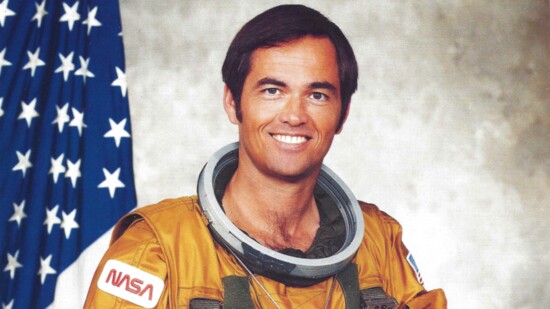In the quiet, unassuming town of Porter, Texas, a boy named Robert (Bob) Crippen dared to dream of flying among the stars. His family moved to the area when he was five after his father was injured in an oilfield accident. Growing up in the small sawmill town, his journey was filled with adventure. Initially a chicken ranch, the family transformed it into a Beer Tavern and Service Station. He and his sister, Betty, rode the school bus to New Caney School, where their imaginations soared. Surrounded by open land, they spent time with horses and other animals, while he also helped at the family’s service station, pumping gas and learning the importance of hard work early on.
Bob’s fascination with flight began early—he immersed himself in books about aviation and idolized pioneers like Chuck Yeager, Scott Crossfield, and Jimmy Doolittle, never imagining that one day he’d meet them as peers. Watching old WWII films and building model airplanes fueled his desire to fly and led him to study Aeronautical Engineering and join the Navy becoming a Naval Aviator. Despite his parents’ fears, they encouraged his independence, allowing him to chase his dreams.
While in college his journey took a thrilling turn when Russia launched the first artificial satellite, leading to the formation of NASA. Inspired by the Mercury Seven, who were all test pilots and four of whom were Naval Aviators, he resolved to follow in their footsteps. "Flying higher and faster sounded good to me," he once said. Although obtaining his degree was challenging, he buckled down and pursued an Aerospace Degree.
Bob’s path to becoming an astronaut wasn’t straightforward. In 1965, while attending Test Pilot School, he seized an incredible opportunity for a highly classified program called the Manned Orbiting Laboratory (MOL). Although the program was canceled for various technical and financial reasons in 1969, his journey didn’t end there; he transitioned to NASA’s Astronaut Office.
While waiting for flights, Bob contributed to groundbreaking projects like Skylab and the Apollo-Soyuz Test Project, collaborating with the Russians during the Cold War. But his most significant work came in helping design the Space Shuttle. In 1981, he served as the pilot of *Columbia* on the first orbital flight of the Shuttle Program. Later, he became the Director of the Space Shuttle program and the Kennedy Space Center, paving the way for future space exploration.
Now retired in South Florida, Bob reflects on his remarkable career. Though he enjoys ocean fishing, his heart remains in the stars. Excited by private industry’s involvement in space exploration and is particularly excited about the Artemis Program, which aims to return humans back to the Moon. He stays connected through his daughter, Susan, who works at Johnson Space Center.
Robert Crippen’s legacy extends beyond his contributions to the space program. In 1995, an elementary school was built in his honor—Robert L. Crippen Elementary School in Porter, Texas. The school serves as a testament to his remarkable achievements and his roots in the small town that shaped his early years. Though Bob is retired, he continues to inspire young minds, occasionally checking in with students via Zoom to share his experiences and passion for space exploration. His story motivates a new generation to reach for the stars, just as he did.
Inspired by the Mercury Seven, who were all test pilots and four of whom were Naval Aviators, he resolved to follow in their footsteps. "Flying higher and faster sounded good to me,"
